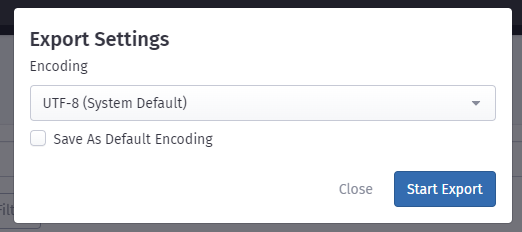UTF-8 (System Default)
Description: UTF-8 is the default encoding for many systems, including most web pages and modern operating systems. It's a variable-width character encoding capable of representing all possible characters in the Unicode standard.
Strengths: It efficiently uses 8-bit units, is backward compatible with ASCII, and supports multiple languages and symbols, making it versatile and ideal for internationalization.
Usage: Often chosen for data exports due to its compatibility across different systems and platforms.
WINDOWS-1252
Description: Also known as "ANSI" or "Windows Latin 1," WINDOWS-1252 is an 8-bit character encoding used primarily in Microsoft Windows. It extends ASCII, including characters for Western European languages and additional symbols.
Strengths: It's backward compatible with ASCII for the first 128 characters and suits Windows-based systems or legacy systems that lack full UTF-8 support.
Usage: Chosen for data exports when dealing specifically with Windows-based systems or needing compatibility with legacy systems.
ISO-8859
Description: The ISO-8859 family of encodings consists of various single-byte character encodings for different languages/regions, such as ISO-8859-1 for Western European languages.
Strengths: Each ISO-8859 variant supports different sets of characters for specific languages or regions.
Usage: Used in situations where specific language character sets are required, although it's less common today compared to UTF-8.
Factors Influencing Choice of Encoding:
Compatibility: If compatibility with older or specific systems is necessary, WINDOWS-1252 or ISO-8859 might be preferred.
Multilingual Support: UTF-8 is better for data involving multiple languages due to its comprehensive Unicode coverage.
Language-Specific Requirements: ISO-8859 may be used when specific language character sets are necessary.
Efficiency: UTF-8's variable byte lengths can save space compared to fixed-width encodings like UTF-16, making it suitable for applications where file size matters.
In summary, while UTF-8 is widely accepted due to its comprehensive character set and compatibility, WINDOWS-1252 and ISO-8859 might be chosen for specific legacy system requirements, language-specific needs, or platforms lacking full UTF-8 support. Ultimately, the choice of encoding depends on the data's specific needs and system interactions.

